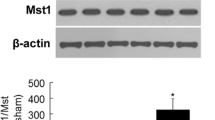Abstract
Macrophage migration inhibitory factor (MIF) is a multipotential protein that acts as a proinflammatory cytokine, a pituitary hormone, and a cell proliferation and migration factor. The objective of this study was to elucidate the role of MIF in spinal cord injury (SCI) using female MIF knockout (KO) mice. Mouse spinal cord compression injury was produced by application of a static load (T8 level, 20 g, 5 min). We analyzed the motor function of the hind limbs and performed histological examinations. Hind-limb function recovered significantly in the KO mice starting from three weeks after injury. Cresyl-violet staining revealed that the number of surviving neurons in the KO mice was significantly larger than that of WT mice six weeks after injury. Immunohistochemical analysis revealed that the number of NeuN/caspase-3-active, double-positive, apoptotic neurons in the KO mice was significantly smaller than that of the WT mice 24 and 72 h after SCI. These results were related to in-vitro studies showing increased resistance of cerebellar granular neurons from MIF-KO animals to glutamate neurotoxicity. These results suggest that MIF existence hinders neuronal survival after SCI. Suppression of MIF may attenuate detrimental secondary molecular responses of the injured spinal cord.




Similar content being viewed by others
References
Abe R, Shimizu T, Ohkawara A, Nishihira J (2000) Enhancement of macrophage migration inhibitory factor (MIF) expression in injured epidermis and cultured fibroblasts. Biochim Biophys Acta 1500:1–9
Akoum A, Kong J, Metz C, Beaumont MC (2002) Spontaneous and stimulated secretion of monocyte chemotactic protein-1 and macrophage migration inhibitory factor by peritoneal macrophages in women with and without endometriosis. Fertil Steril 77:989–994
Bernhagen J, Calandra T, Mitchell RA et al (1993) MIF is a pituitary-derived cytokine that potentiates lethal endotoxaemia. Nature 365:756–759
Bloom BR, Shevach E (1975) Requirement for T cells in the production of migration inhibitory factor. J Exp Med 142:1306–1311
Farooque M (2000) Spinal cord compression injury in the mouse: presentation of a model including assessment of motor dysfunction. Acta Neuropathol 100:13–22
Farooque M, Isaksson J, Olsson Y (2001) Improved recovery after spinal cord injury in neuronal nitric oxide synthase-deficient mice but not in TNF-alpha-deficient mice. J Neurotrauma 18:105–114
Fujimoto S (1997) Identification of macrophage migration inhibitory factor (MIF) in rat spinal cord and its kinetics on experimental spinal cord injury. Hokkaido Igaku Zasshi 72:409–430 Japanese
Honma N, Koseki H, Akasaka T et al (2000) Deficiency of the macrophage migration inhibitory factor gene has no significant effect on endotoxaemia. Immunology 100:84–90
Koda M, Nishio Y, Hashimoto M et al (2004) Up-regulation of macrophage migration- inhibitory factor expression after compression-induced spinal cord injury in rats. Acta Neuropathol 108:31–36
Niino M, Ogata A, Kikuchi S, Tashiro K, Nishihira J (2000) Macrophage migration inhibitory factor in the cerebrospinal fluid of patients with conventional and optic-spinal forms of multiple sclerosis and neuro-Behçet’s disease. J Neurol Sci 179(S 1–2):127–131
Nishihira J (1998) Novel pathophysiological aspects of macrophage migration inhibitory factor (review). Int J Mol Med 2:17–28
Ogata A, Nishihira J, Suzuki T, Nagashima K, Tashiro K (1998) Identification of macrophage migration inhibitory factor mRNA expression in neural cells of the rat brain by in situ hybridization. Neurosci Lett 246:173–177
Oshima S, Onodera S, Amizuka N et al (2006) Macrophage migration inhibitory factor-deficient mice are resistant to ovariectomy-induced bone loss. FEBS Lett 580:1251–1256
Plesnila N, von Baumgarten L, Retiounskaia M et al (2007) Delayed neuronal death after brain trauma involves p53-dependent inhibition of NF-kappaB transcriptional activity. Cell Death Differ 14:1529–1541
Raivich G, Liu ZQ, Kloss CU et al (2002) Cytotoxic potential of proinflammatory cytokines: combined deletion of TNF receptors TNFR1 and TNFR2 prevents motoneuron cell death after facial axotomy in adult mouse. Exp Neurol 178:186–193
Santos LL, Morand EF (2006) The role of macrophage migration inhibitory factor in the inflammatory immune response and rheumatoid arthritis. Wien Med Wochenschr 156:8–11 Review
Stosic-Grujicic S, Stojanovic I, Maksimovic-Ivanic D et al (2008) Macrophage migration inhibitory factor (MIF) is necessary for progression of autoimmune diabetes mellitus. J Cell Physiol 215:665–675
Weber UJ, Bock T, Buschard K, Pakkenberg B (1997) Total number and size distribution of motor neurons in the spinal cord of normal and EMC-virus infected mice—a stereological study. J Anat 191:347–353
Zhao Y, Shimizu T, Nishihira J et al (2005) Tissue regeneration using macrophage migration inhibitory factor-impregnated gelatin microbeads in cutaneous wounds. Am J Pathol 167:1519–1529
Acknowledgments
We thank Dr Toshinori Nakayama of Department of Immunology, Graduate School of Medicine, Chiba University, for management of animal supply and useful discussions about this paper.
Author information
Authors and Affiliations
Corresponding author
Rights and permissions
About this article
Cite this article
Nishio, Y., Koda, M., Hashimoto, M. et al. Deletion of macrophage migration inhibitory factor attenuates neuronal death and promotes functional recovery after compression-induced spinal cord injury in mice. Acta Neuropathol 117, 321–328 (2009). https://doi.org/10.1007/s00401-008-0476-x
Received:
Revised:
Accepted:
Published:
Issue Date:
DOI: https://doi.org/10.1007/s00401-008-0476-x




